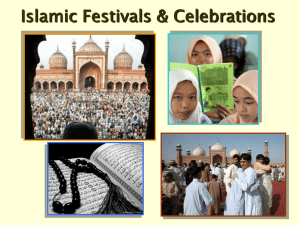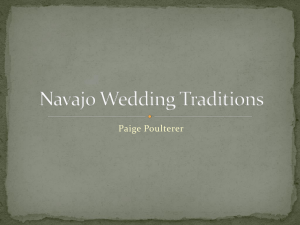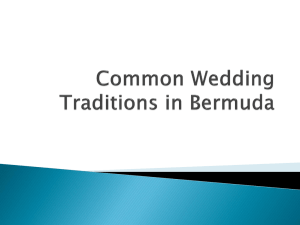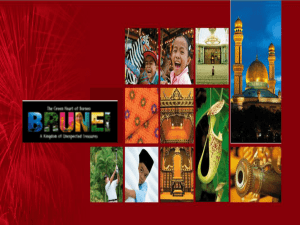customs and traditions INTRODUCTION:
advertisement
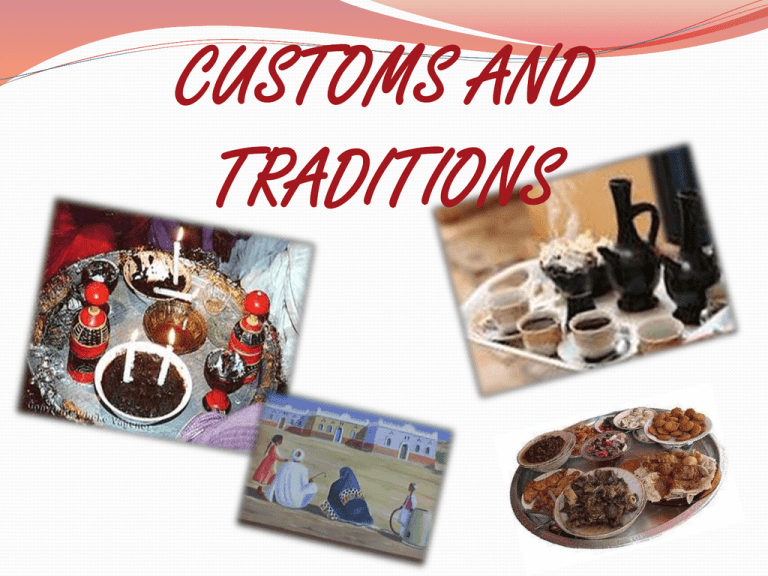
CUSTOMS AND TRADITIONS INTRODUCTION: Customs and traditions are vary from country to another because each country has it's own customs and traditions. A tradition is a belief which passed down within a society in the past, and still maintained in the present. Common examples include holidays, clothes ,food, happy and sad occasions and also occasions which related to the religion . this is also applied to social norms such as greetings and the ways of welcoming guests. Traditions and customs can last for thousands of years and still reserved while new traditions continue to appear over the years. Sudanese Hospitality: Many people are talking about the kindness and hospitality that offered by Sudanese people. The Sudanese people are very generous and hospitable. When guests come to Sudanese homes they always welcome them in a friendly and generous manner. They also make it their duty to entertain their guests, and to make them comfortable. Sudanese people are well known for their unique brand of hospitality both to Sudanese friends as well as to any people who come to the Sudan from other countries. Every Sudanese of the family believes that it is his duty to maintain into his children a sense of hospitality. Because those children will be the parents of the future and they will influence the values of our society. This practice has dominated Sudanese lives and their ways of thinking. You can find people travelling to distant places inside the Sudan without carrying any food with them. Yet they are always sure of finding food and even a place to stay. Whenever a Sudanese guest is present, either for business or for social reasons, he will be presented with a drink and some other refreshment such as small pieces of candy and cake or other refreshments. And if someone asked a Sudanese person if he had such a thing, he will simply offers it. Of course the ways of showing hospitality are different from one area to another. But in all areas the tradition of welcoming and looking after their guests is the same. Greeting: The customs of greeting upon two men meeting each other is to shake hands and tap each other’s shoulder at the same time. A hug and rubbing of cheeks may be exchanged between Sudanese ladies and their friends. Traditional clothing for Sudanese men: However, most individual Sudanese wear either traditional or western clothes. A traditional garb for men that worn in Sudan is the “jalabiya”, which is a loosefitting, long-sleeved and white colored with “sirwal” (loose pants) and “taqia”(cap) and “imma” (a long turban) and “markoob” (leather shoe). The jalabiya is accompanied by a large scarf worn by men “shal”, and the garment may be white, colored, striped, and made of fabric varying in thickness, depending on the season of the year and personal preferences. The “taqia” is a short and rounded cap. It can be any colour. Some Sudanese Muslims wrap the “imma” (turban) around the cap. “Markoob” is a traditional Sudanese shoe for men. It is made of leather. Traditional clothing for Sudanese women: Sudanese woman wears a traditional “thawb”. "Thawb" means "garment" in Arabic, and the thawb itself is the traditional clothes for Sudanese women. “Thawb” is a long and wrapped around the body. And it has different colours and textures. Food in Daily Life: The day usually begins with a cup of tea. Breakfast is eaten in the mid- to late morning, generally consisting of beans, salad, and bread. Millet is the staple food in some areas, and it is prepared in as a porridge called ‘’asida’’ or ‘kisra’’. Vegetables are prepared in stews or salads. A dish of broad beans “ful” is common in Sudan. Nomads in the north rely on dairy products and meat from camels. In general, meat is expensive and not often consumed. Sheep are killed for feasts or to honour or a special guest. The intestines, lungs, and liver of the animal are prepared with chilli pepper in a special dish called “marara”. Sometimes cooking is done in the courtyards outside the house on a tin grill called a “kanoon”, which uses charcoal as fuel. Tea and coffee are both very popular drinks. Coffee beans are fried, and then ground with cloves and spices. Then the liquid is Poured into sieve and served in tiny cups. Food Customs at Ceremonial Occasions: At the Eid al-Adha, the Feast of the Great Sacrifice, it is customary to kill a sheep, and to give part of the meat to people who cannot afford it themselves. At Eid al_Adha Sudanese people prepare a large family meal of sheep meet with chilli and other dishes .The Eid al-Fitr, or Breaking of the Ramadan Fast is another joyous occasion, and it also involves a large family meal. The birthday of the Prophet Muhammad is primarily a children's holiday, celebrated with special desserts: pink sugar dolls and sticky sweets made from nuts and sesame seeds. Sudanese henna: Henna is a beautiful Sudanese tradition. Henna is a paste that is made from the leaves of the Henna bush. The leaves are picked and made into a powder. Then water is added to the powder until it gets pasty. The paste is put into a cone that can be made of a sturdy plastic bag, and then it is used like a pen to draw beautiful drawings on the hands or feet. It is left to dry, then washed off. Henna is a beautiful Sudanese tradition. Henna is a paste that is made from the leaves of the Henna bush. The leaves are picked and made into a powder. Then water is added to the powder until it gets pasty. The paste is put into a cone that can be made of a sturdy plastic bag, and then it is used like a pen to draw beautiful drawings on the hands or feet. It is left to dry, then washed off. If you are careful, your henna can last for over three weeks before fading away! Traditional designs are mostly of roses and flowers. They’re very popular and mostly done on the hands and feet. Men also use “henna” .They put it on their hands and feet for their weddings! In the groom's "Henna party" right before the wedding, his mother, sisters, and aunts get together, sit him on a decorated bed, and put henna on his feet and his hands (not drawing). Meanwhile, all his female relatives are singing and dancing, and his brothers and guy friends all get one hand "hennaed"! Henna has been used for over 5000 years in many countries around the world to decorate women's hands and feet, and especially married women and brides. Some make it light orange, some make it red, but Sudanese like to make it BLACK and shiny ! Wedding in Sudan: Wedding is one of the most important occasions in Sudan. It reflects the culture and hospitality of the Sudanese people . The arrangement of it begins before two months when the bridegroom family comes to the bride family to give them “ALSHAILA” which is a big group of clothes, creams and perfumes for the bride. It also includes the money that called “goltalkhair”. About two days before the wedding the bride invites her friends for “El Henna”. On this day “Al_hannana” comes to decorate the hands and legs of the bride with henna and also her girlfriends. Then they dance and sing and spend a happy day together. That night the groom also has his Henna night with his friends and relatives. The groom doesn't decorate his legs, only his fingertips and bottom of feet. This is done for him by his mother or one of his female relatives. All his male friends do the same on their hands. The wedding party "Al-Dukhla" takes place in houses, large tents, in the streets or in clubs. The bride's family gets a singer or DJ. There's a lot of music and dancing and a beautiful dinne is served. Everyone is invited and everyone is happy. The bride wears a white wedding gown and the groom wears a black tuxedo. On the first day of the marriage, “Al Subhia”, the bride's mother invites all the women of the family and the girlfriends of the bride. Only certain men can attend the “Subhiya” : the bride's father, brothers, uncles, and the groom. The bride dances three or four dances for her audience, changing dresses for each dance. A woman sings and drums on the "dallooka" songs that all the girls know, and they all sing along, clap and have a great time! After she finishes dancing, it's time for the final ritual called the "Jirtig". It has special traditions, and a special red and yellow tray with pottery to put the perfumes and “bakhoor” in . The bride wears a red tobe and the bridegroom wears a white jallabia with red and golden strips on it. They sit on a bed with a beautiful decorated red and gold sheet called “milayat aljirtig”. All the elder women around them. And one of the older women comes and wishes the happy couple wealth, health and the blessing of children upon them. She sings “aladeel walzain” while perfuming them, and ties “alhareera” and "hilaal" around the groom's head, and the "sibha" around his neck. After that the groom cuts “alrahat” which is a robe that tied around the bottom of the bride and there are some dates and sweets. After cutting it the groom throws it into the single ladies. In Sudanese traditions when a lady catches “alrahat” that means she will marry soon. The groom gets up and sprays the audience with perfume. Then the woman offers them a cup of milk. They both take a drink and spray it over each other as a sign of love, peace and hope for a clean, pure life together- pure as milk.ts tied on it. Ramadan: Manifestations of the social and religious celebrations in the Sudan are varied. Ramadan is one of the religious customs in Sudan .it is the ninth month of the Islamic calendar, which lasts 29 or 30 days. It is the Islamic month of fasting, in which participating Muslims refrain from eating, drinking and smoking. Villagers, who work in different Sudanese towns and abroad, return to their villages ahead of Ramadan. Those include employees, workers and also students. The mosques are crowded with worshippers all the day .people have religious programs throughout the day including Koran recitations between midday and afternoon prayers. Exhibitions of religious books are also displayed within the mosque courtyard. Men and women throng apart to perform the “Taraweeh” (the nightly prayers), which are performed only during Ramadan. During the “Taraweeh”, one chapter of the 30 chapters is recited; winding up the whole holy book by the end of Ramadan, and each “Taraweeh” is concluded with invocations and poems on the Prophet Mohammad. The worshippers intensify their worshipping activities at the last ten days of “Ramadan”. They remain in the mosque till dawn, in the hope of witnessing “Laylat al-Qadr” (the night which God respond the pray). The Program of “Khalwah” (a room where students are secluded to memorize the Holy Koran) is run throughout the year, including the fasting month of Ramadan, except that, during Ramadan, the Koran students are distributed in groups to families of the village to share the sunset breakfast. Sudanese Good habits during Ramadan: Drinking Water: A remarkable habit in the Sudanese villages during Ramadan is that people get together in large numbers on the main streets for the sunset breakfast; a group of the elders stand at the cross-roads to insistently invite passersby to join in and they never allow anybody to pass by without accepting the invitation to share the breakfast. They even force the drivers to stop by placing stones on the road minutes before the breakfast time and drivers will have no alternative other than park and get down for the breakfast. Carpets and prayer rugs are stretched for people to have breakfast and perform prayers on after the meal. Usually, those carpets are kept in a certain house and are taken out only during Ramadan. Men and boys of neighbouring houses usually have the sunset breakfast together. Well before the Azan (call for prayers) the men sit down on the carpets while the young men bring in from the houses trays full of a variety of delicious foods and juices and immediately after the Azan, every one sits down to eat and drink, starting with a date as a must like what Mohammad the Prophet used to do, from the nearest tray, not necessarily the one brought from his house, signifying solidarity and equality between the poor and rich. Ramadan Tray: Ramadan tray contains genuine Sudanese foods and drinks, particularly “asida” (porridge made from sorghum), “hilu-mur” (sweet-bitter, a drink made from sorghum and all kinds of spices) and “kerkede” drink, “aradaib” ,“tabalde”, lemon and various kinds of fruit and juices. After eating dates and drinking, all worshippers line up behind the imam to say sunset prayers and immediately after that they all assault the trays to squash thirst and defeat hunger. Ramadan Food: Ramadan is regarded a return to the original Sudanese kitchen and housewives call in their long experience and prepare genuine delicious Sudanese dishes and foods, including “kisra” which is made from sorghum, “gurrasah” which is made from wheat flour, salads and other kinds of highly nutrient and delicious foods. “AL-Eid”: The Moslems have two Eids.The first one is Ramadan Eid(Eid alfitr) and the second one is the Eid of Sacrifice, or the Eid of Haj (Eid aladha). “Eid alfitr”: when The holy month of Ramadan is about to finish families are preoccupied with preparations for the Eid alfitr as was the case before the advent of Ramadan. Sudanese like other Muslims across the globe they prepare for the Eid, most gracious feast and beautiful in Islam. In the Eid The markets and shops are full of people despite the increasing of prices. people buy new clothes, bed sheets, redecorating their houses, some event are replacing old furniture with new one, all types of sweets, etc… In the past, there used to be different types and shapes of cakes. The traditional shapes like (soft cake, biscuits, bidebford and alghariba), but today there are new shapes and names of cakes. many women are frequenting beauty shops to come out in their attractive look during the Eid days. “Eid aladha”: Eid al_Adha the feast of the great sacrifice, it is customary to kill a sheep, and to give a part of meat to people who cannot afford it themselves . Al eid al-kabir (the greater aid) also called Eid alAdha is one of the two most important Islamic festivals, Eid al-Adha begins on the 10th day of Dhu'l-Hijja, the last month of the Islamic calendar. Lasting for three days, it occurs at the conclusion of the annual Hajj, or pilgrimage to Mecca. Muslims all over the world celebrate Eid al-Adha, not simply those undertaking the hajj, which for most Muslims is a once-a-lifetime occurrence. OUR TEAM: Malaz Zakaria Sara Omer Rawia Mirghani Sara Osman Solafa Ali

